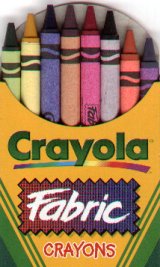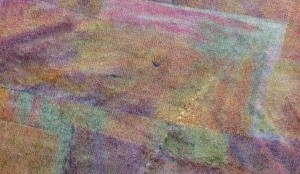Transprint Inks
sometimes called transfer paints, are made from dyes which were developed to colour synthetic fabrics that were otherwise difficult to dye. They are painted onto non-absorbent paper (such as photocopy/computer paper), left to dry, and then ironed onto the fabric.

The result is a good colour that is colourfast to light and washing. A great advantage of these paints is that several prints can be made from each painted paper.

'Heat Phonograms" can be created if objects such as lace, feathers, wire or string are placed between the fabric and a painted paper - acting as a mask
![]()
Types of Fabrics to use
Synthetic or partially synthetic fabrics - the higher the synthetic content the stronger and more permanent the colour. Types include woven, novelty, metallic and sheer. Synthetic velvets are particularly effective. Old plain coloured polyester sheets, shirts and nets are good for practising on.
There are many ways to apply paint - try printing, spraying, dabbling, dipping or rolling. Apply with a brush, roller, sponge, cotton buds, fingers, feathers, twigs.
Paint up lots of papers and use them when you need to. You can cut up your papers, weave them, apply one over another, cut out shapes.

Crayola Fabric Crayons
- are fun and easy to use. Layer to create new tones - vary the pressure to achieve dark and pale tones. Try solid colouring, diagonal or scribble shading.
Very effective when used for rubbings - try walls, pavement, fences, tree trunks, car tyres, plastic mesh, leaves.
Ironing to Fabric
Make sure your papers are dry - use a hot iron - lay the paper(s) face down on the fabric - cover with baking paper and iron.

Experiment and have fun!